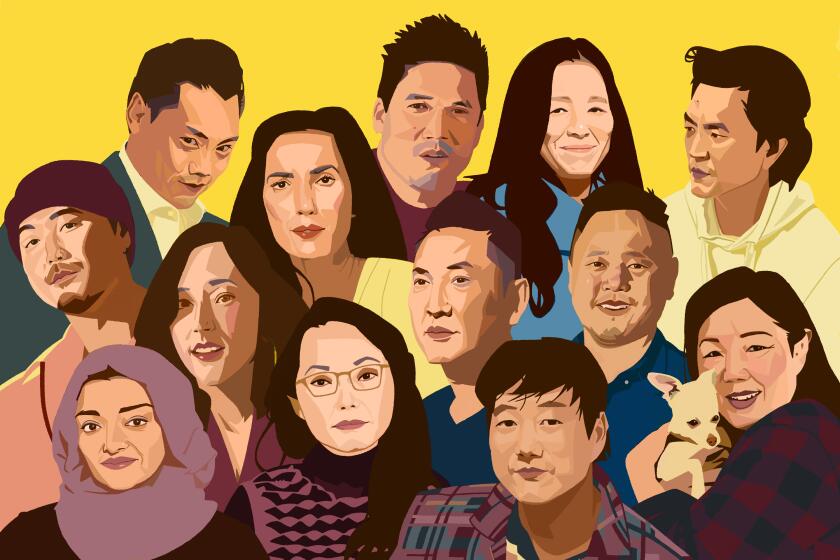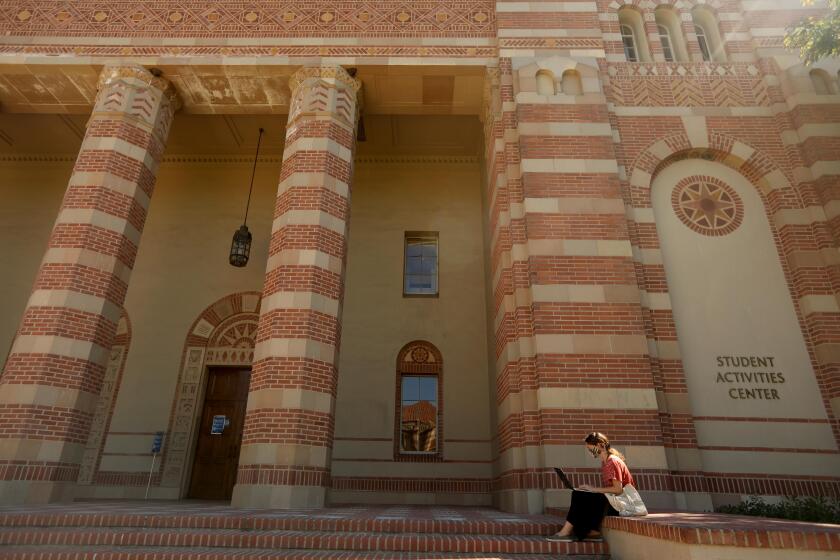Column: Kamala Harris’ identity shows us the limits of our labels
- Share via
It was just the Tamil word for auntie, two syllables in a speech by Kamala Harris last Thursday that covered her childhood, heritage and political awakening and culminated in her acceptance of the Democratic Party nomination for vice president.
But “chithi,” uttered on a presidential stage for the first time and pronounced correctly at that, set millions of Whatsapp chats ablaze around the world. A photo of a young Kamala and her sister Maya in saris and bindis with their grandparents in India circulated furiously. Nationalistic pride, political optimism and representational joy combined in a celebratory moment that was largely absent when Harris announced her presidential candidacy last year.
For a moment, a lot of us contemplated the idea of a vice president — someday, maybe even a president — shaped by the sacrifice of immigrant parents, who might feel the pain and injustice of country-specific travel bans in their own family, or have some sense of what it’s like to sip coffee from a Starbucks cup with someone else’s simpler-to-spell name on it.
Even I felt my own cynicism fading ever so slightly. Presidential elections, for better or for worse, spark wide-ranging conversations about race. And Harris, an Oakland-born daughter of Indian and Jamaican immigrants, who is both Black and Asian American, possesses an identity so multifaceted that it threatens to make that conversation a little bit smarter.
But presidential elections, for those accustomed to discussing race intelligently, can also be unfortunate markers of how little progress we have made.
And the enduring poverty of our racial rhetoric was on full display the night of Harris’ nomination, when it seemed no news outlet, poster or commentator could agree on how to identify her, variously describing her heritage as a woman of color, a child of immigrants, Black, Asian American, African American, Jamaican American, Indian American and South Asian.
On social media, I saw people fighting over the way Harris was described and pressing their own claims to her identity, various labels flying like flags over ideological fortresses. Pro-Trump commentators weaponized Harris’ biography, claiming first that her Jamaican and then her Indian heritage meant that she did not understand the African American experience. Political operatives even tried to sell the absurd and instantly disproved lie that Harris was ineligible for the role because she was the daughter of immigrants. It was a near echo of the attacks that Barack Obama faced during his presidency.
Identity is always more complex than the labels used to describe it. When I report in ethnic neighborhoods across the city, I’m constantly reminded that behind the label is a story, and although the label doesn’t always fit, the story always makes sense when you hear it.
And I was fortunate to get that chance two months ago, when Harris agreed to appear on our Los Angeles Times podcast “Asian Enough.”
On our podcast, my co-host Jen Yamato and I talk about Asian American identity and how the labels this country uses often don’t fit. Perhaps unsurprisingly, Harris was game for the conversation.
“Asian Enough” is a podcast about being Asian American — with guests like John Cho, Lulu Wang, Mina Kimes, Margaret Cho and Padma Lakshmi.
We talked about her mother’s cooking — Indian, but also barbecue and Italian pasta — and how her mother raised Kamala and her younger sister, Maya, as Black women because she understood that that’s how her daughters would be seen.
Harris argued that she was not presenting a confused picture of her identity, as she’s often accused of doing — but that it was instead America itself that was confused about race. She described the pressure of choosing between Indian and Black identities as a “false choice,” an idea I immediately understood as the U.S.-born son of Taiwanese immigrants who feels connections to both countries.
Harris was smooth and occasionally spoke in sound bites as you’d expect of a politician as skilled and as experienced as she is. But there were moments when genuine frustration about the labels applied to her cracked through. “I didn’t go through some evolution about who am I and what is my identity. And I guess the frustration I have is if people think that I should have come through such a crisis and need to explain it. But I didn’t,” Harris said.
Perhaps our interview was just as much political performance as anything a politician does. But Harris has consistently resisted choosing among the multiple facets of her identity. Instead of putting on the most expedient label available and wearing it like a mask, I saw Harris attempting to explain her complexity.
Identity, and the terms to describe it, are easy targets these days as more people exhausted by our daily outrage cycles tap out of engaging on issues of race.
But if we don’t understand race ourselves, we will be manipulated by people who do. Voters from communities of color have long been familiar with the way Democrats and Republicans alike have marketed multiculturalism for votes and political gain, without ever delivering change for those communities. But now race is also a marketing tool, a brand, a trend and a hashtag. We have companies and brands using race to sell us chicken sandwiches, airplane tickets and streaming content.
And our racial picture won’t get clearer if we keep coloring with the same three or four dusty, broken crayons. The world is not about to get less complicated. At least half of all children in California have at least one immigrant parent. A Pew study estimated that multiracial people make up 7% of the nation’s population, and that number is expected to triple over the next few decades — a faster rate of growth than any other racial or ethnic group.
All this is to say: We’re going to have to learn some new terms, and also understand that those labels can’t tell the full story.
After all, what label would you use to describe the Harris household, where two Black and South Asian daughters grew up dancing to Aretha Franklin in the living room as their Indian immigrant mother prepared dinners of daal, barbecue and beef stir-fry?
I have no idea. And there’s something exciting about that.
More to Read
Sign up for Essential California
The most important California stories and recommendations in your inbox every morning.
You may occasionally receive promotional content from the Los Angeles Times.












